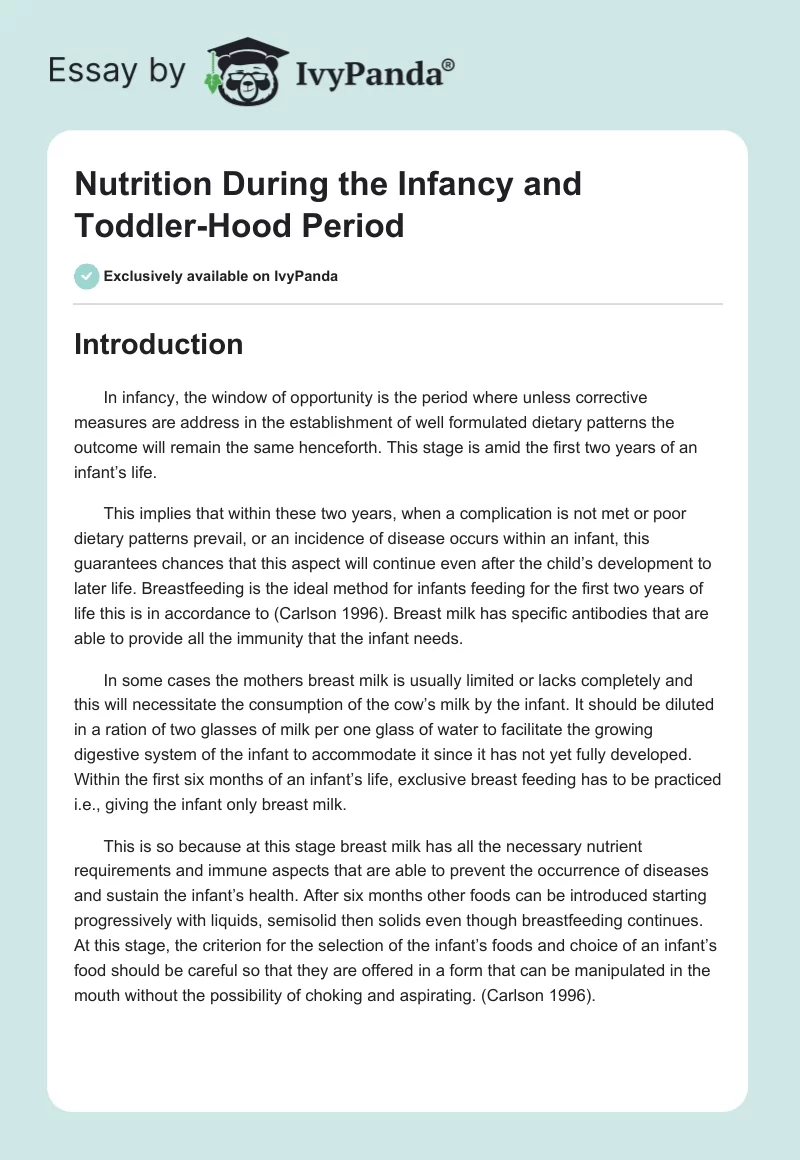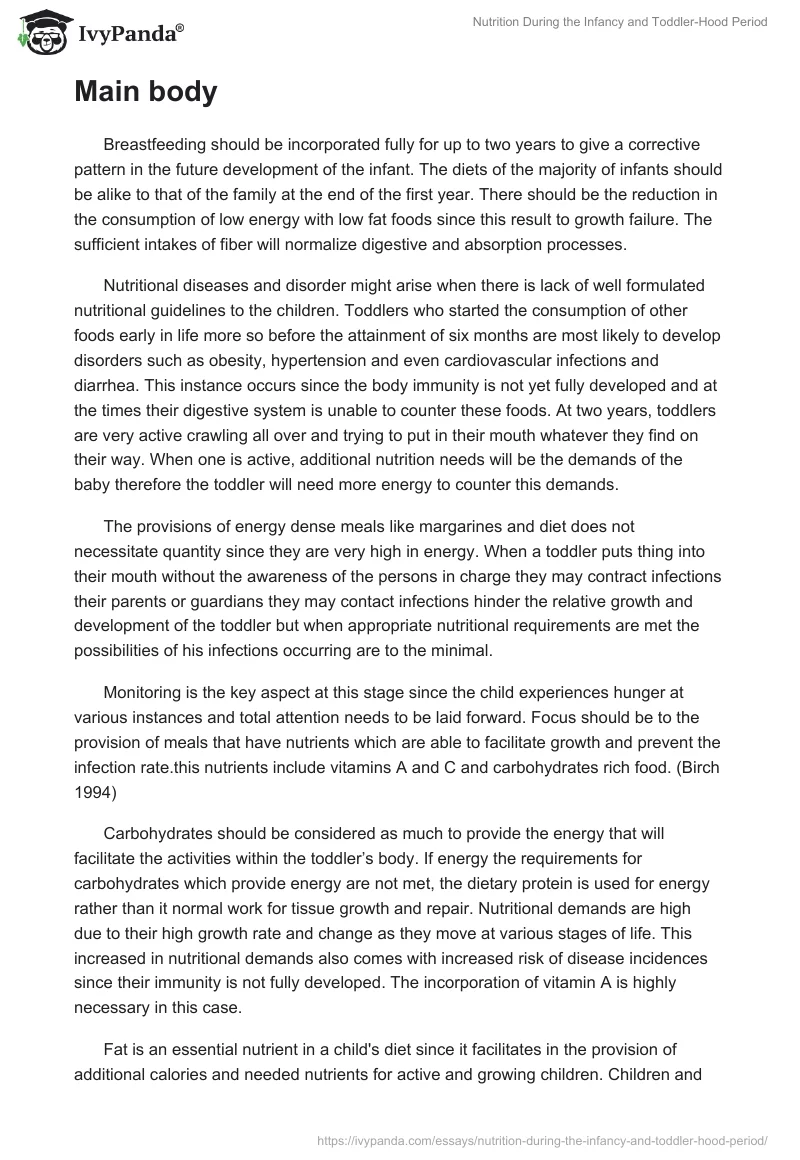Introduction
In infancy, the window of opportunity is the period where unless corrective measures are address in the establishment of well formulated dietary patterns the outcome will remain the same henceforth. This stage is amid the first two years of an infant’s life.
This implies that within these two years, when a complication is not met or poor dietary patterns prevail, or an incidence of disease occurs within an infant, this guarantees chances that this aspect will continue even after the child’s development to later life. Breastfeeding is the ideal method for infants feeding for the first two years of life this is in accordance to (Carlson 1996). Breast milk has specific antibodies that are able to provide all the immunity that the infant needs.
In some cases the mothers breast milk is usually limited or lacks completely and this will necessitate the consumption of the cow’s milk by the infant. It should be diluted in a ration of two glasses of milk per one glass of water to facilitate the growing digestive system of the infant to accommodate it since it has not yet fully developed. Within the first six months of an infant’s life, exclusive breast feeding has to be practiced i.e., giving the infant only breast milk.
This is so because at this stage breast milk has all the necessary nutrient requirements and immune aspects that are able to prevent the occurrence of diseases and sustain the infant’s health. After six months other foods can be introduced starting progressively with liquids, semisolid then solids even though breastfeeding continues. At this stage, the criterion for the selection of the infant’s foods and choice of an infant’s food should be careful so that they are offered in a form that can be manipulated in the mouth without the possibility of choking and aspirating. (Carlson 1996).
Main body
Breastfeeding should be incorporated fully for up to two years to give a corrective pattern in the future development of the infant. The diets of the majority of infants should be alike to that of the family at the end of the first year. There should be the reduction in the consumption of low energy with low fat foods since this result to growth failure. The sufficient intakes of fiber will normalize digestive and absorption processes.
Nutritional diseases and disorder might arise when there is lack of well formulated nutritional guidelines to the children. Toddlers who started the consumption of other foods early in life more so before the attainment of six months are most likely to develop disorders such as obesity, hypertension and even cardiovascular infections and diarrhea. This instance occurs since the body immunity is not yet fully developed and at the times their digestive system is unable to counter these foods. At two years, toddlers are very active crawling all over and trying to put in their mouth whatever they find on their way. When one is active, additional nutrition needs will be the demands of the baby therefore the toddler will need more energy to counter this demands.
The provisions of energy dense meals like margarines and diet does not necessitate quantity since they are very high in energy. When a toddler puts thing into their mouth without the awareness of the persons in charge they may contract infections their parents or guardians they may contact infections hinder the relative growth and development of the toddler but when appropriate nutritional requirements are met the possibilities of his infections occurring are to the minimal.
Monitoring is the key aspect at this stage since the child experiences hunger at various instances and total attention needs to be laid forward. Focus should be to the provision of meals that have nutrients which are able to facilitate growth and prevent the infection rate.this nutrients include vitamins A and C and carbohydrates rich food. (Birch 1994)
Carbohydrates should be considered as much to provide the energy that will facilitate the activities within the toddler’s body. If energy the requirements for carbohydrates which provide energy are not met, the dietary protein is used for energy rather than it normal work for tissue growth and repair. Nutritional demands are high due to their high growth rate and change as they move at various stages of life. This increased in nutritional demands also comes with increased risk of disease incidences since their immunity is not fully developed. The incorporation of vitamin A is highly necessary in this case.
Fat is an essential nutrient in a child’s diet since it facilitates in the provision of additional calories and needed nutrients for active and growing children. Children and toddlers should not be exempted from the consumption of fat. For those whose age is above two years, fat intake should represent about thirty percent of the total caloric intake. Lower fat intake of up to thirty percent intake by infants and toddlers may be linked with inadequate consumption of vitamins and minerals that results to an increased risk of poor growth and development the Diets that are higher in fat may result to higher energy intakes and higher body fat.
The practical impact of low-fat diets for infants and toddlers should be estimated in conditions of maturation, immune defense, and neural development. (Birch 1994) Sometimes this consumption result to deposition of adipose therefore the child might end up, being obese therefore regulation should be totally embraced to minimize the over consumption of this fats.
Conclusion
Parent and those taking care of the should guarantee that what is good for the child is taken into account so that the health of the child is sustained. Poor nutrition practice is always a characteristic of nutritional disorders and diseases and in infants malnutrition can easily crop up. All parents need children who are healthy at all times. It is from this that good practices that the children and toddlers will be seen since one will try as much as possible to minimize his occurrence to save the cost ha might develop to become future obstacles in the Child’s life. Healthy development in infants and toddlers actually emerge when proper nutrition has take place in most of the times.
Reference
Carlson, S. (1996). The role of nutrition in development. American Journal of Clinical Nutrition, 63 (6), 997S-1001S.
Birch LL. (1994).Infant dietary experience and acceptance of solid foods. Pediatrics;93:271-277.


